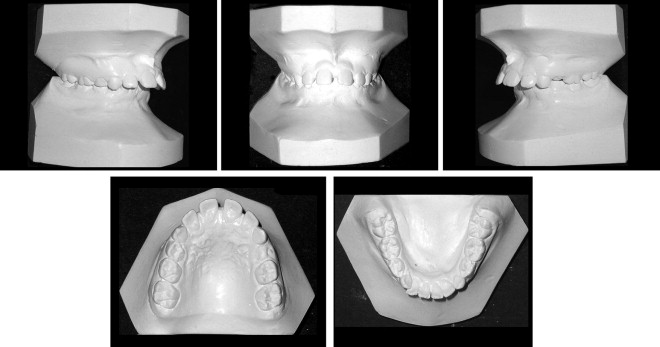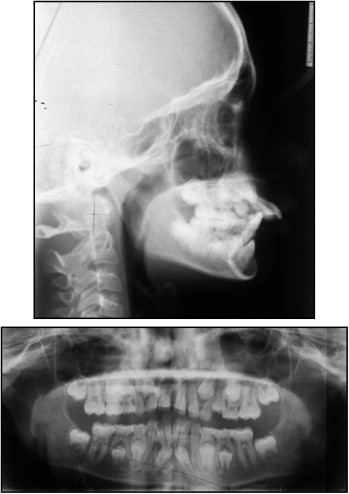Multiple treatment options are available to patients with impacted manibular canines in addition to a retained deciduous canine. This article describes the treatment of a prepubertal girl, aged 10 years 6 months, with a skeletal Class I, dental Class II Division 1 malocclusion, retrognathic mandible, deep overbite, proclined maxillary incisors, midline diastema, and bilateral mandibular canine impaction. The orthodontic treatment plan included extraction of the deciduous canine and forced eruption of the impacted canines. A modified lip bumper appliance was used both for forced eruption and to reinforce anchorage. Through the collaborative efforts of an orthodontist and an oral surgeon, an excellent esthetic and functional outcome was achieved.
In the human dentition, maxillary and mandibular canines are a necessity from both esthetic and functional perspectives. Maxillary canines are the most commonly impacted teeth after the third molars. Most impacted canines remain asymptomatic; however, a number of potential implications have been suggested: labial or lingual malpositioning of the impacted tooth; migration of the neighboring teeth and loss of arch length; external root resorption of the impacted tooth and the neighboring teeth; infection, particularly with partial eruption resulting in pain and trismus; and referred pain. Unerupted or partially erupted canines can increase the risk of infection and cystic follicular lesions and can compromise the life span of neighboring lateral incisors caused by root resorption.
The incidence of mandibular canine impaction is about 20 times less than impaction of the maxillary canines. Treatment options for mandibular canine impaction are surgical extraction with premolar substitution, autotransplantation, and surgical exposure and eruption into the dental arch. Factors that influence the potential problems and complexity for the treatment of impacted canines are timing of the orthodontic treatment, type of surgical procedure to expose the impacted tooth, orthodontic mechanics, position of the impacted tooth in the arch, and eruption status of neighboring teeth. Maxillary canines erupt by the age of 11 to 13 years; when the signs and symptoms of impacted canines are evident, nearly all permanent teeth except the second and third molars are present in the oral cavity. Unlike the maxillary canines, the mandibular canines erupt by the age of 9 to 10 years, and the permanent incisors and first molars are the only other permanent teeth erupted by this time, resulting in an increased demand for anchorage control for the management of impacted mandibular canines. This case report describes the treatment of a patient with bilateral mandibular canine impactions in the midsymphyseal region.
Diagnosis and etiology
A girl, aged 10 years 6 months, came with a chief complaint of proclined maxillary anterior teeth and increased overjet. She was diagnosed with a skeletal Class I and dental Class II Division 1 malocclusion with a retrognathic mandible, deep overbite, proclined maxillary incisors, midline diastema, and bilateral mandibular canine impaction.
Her medical history was not contributory. The pretreatment facial photographs showed a brachyfacial, symmetric face and a convex soft-tissue profile caused by a retrognathic mandible. Upon smiling, 7 mm (90%) of occlusogingival length of the maxillary central incisors was visible ( Fig 1 ). The lower lip was everted, and there was no functional problem. The pretreatment intraoral photographs and dental casts showed that the patient was in the mixed dentition. The first and second deciduous molars, permanent incisors, and first permanent molars were erupted in the oral cavity. She had maxillary and mandibular dental midlines coincident with her facial midline. The overbite was deep at 70%, with the mandibular incisors touching the palatal mucosa. Overjet was 8 mm. There were 8 mm of spacing in the maxillary arch and 1 mm of crowding in the mandibular arch. The molar relationship was end-on (Class II) half a cusp width distoclusion of the molars on both the sides ( Fig 2 ).


The pretreatment lateral cephalogram and orthopantomogram ( Fig 3 ) showed that both mandibular canines were impacted apically and labially to the mandibular incisors, in a mirror-image-like pattern, with both canines in the midsymphyseal region of the mandible. The long axes of the right and left impacted canines had angles of 35° and 24°, respectively, with the midline on the panoramic radiograph. The crowns of both canines could be palpated digitally in the labial mandibular sulcus. No signs of external apical root resorption were observed on the roots of the deciduous canines. The cephalometric analysis ( Table ) showed a skeletal Class I relationship (ANB angle, 3°) with a flat mandibular plane angle (SN-GoGn angle, 27°), a retrognathic mandible (SNB angle, 75°), proclined maxillary incisors (U1-NA, 12 mm and 59°), and upright mandibular incisors (L1-NB, 4 mm and 27°).

| Pretreatment | Posttreatment | Postretention | |
|---|---|---|---|
| SNA | 78° | 80° | 80° |
| SNB | 75° | 78° | 78° |
| ANB | 3° | 2° | 2° |
| Occ-FH | 6° | 4° | 4° |
| SN-GoGn | 27° | 25° | 25° |
| FMA | 20° | 18° | 18° |
| U1-SN | 130° | 116° | 117° |
| U1-NA | 12 mm, 59° | 7 mm, 35° | 8 mm, 37° |
| L1-NB | 4 mm, 27° | 6 mm, 33° | 6 mm, 34° |
| IMPA | 101° | 108° | 109° |
| Y-axis | 57° | 55° | 55° |
| G′-Sn-Pg′ | 153° | 160° | 160° |
| Ul-L1 | 100° | 110° | 109° |
| U1-A-Pg | 14 mm | 9 mm | 10 mm |
The reported frequencies of mandibular canine impaction range from 0.05% to 0.4%. No definitive etiology has been reported as a causative agent for mandibular canine impactions. However, genetics, obstructions to the eruption path, and abnormal displacement of the dental lamina in embryonic life might lead to impaction or ectopic eruption of the mandibular canines.
Treatment objectives
The treatment objectives for this patient were as follows: (1) get the bilaterally impacted mandibular canine into the arch, (2) correct the deep overbite and the increased overjet, (3) close the spaces in the maxillary arch, (4) correct the malalignment of the mandibular anterior teeth, (5) achieve bilateral Class I canine and molar relationships, and (6) improve the facial balance.
Treatment objectives
The treatment objectives for this patient were as follows: (1) get the bilaterally impacted mandibular canine into the arch, (2) correct the deep overbite and the increased overjet, (3) close the spaces in the maxillary arch, (4) correct the malalignment of the mandibular anterior teeth, (5) achieve bilateral Class I canine and molar relationships, and (6) improve the facial balance.
Treatment alternatives
The possible solutions for correction of the impacted mandibular canines were the following.
- 1.
Extraction of the bilaterally impacted mandibular canines, while preserving the deciduous canines to function in place of the permanent canines. Although there was no obvious external apical root resorption of the mandibular deciduous canines, these teeth would not be bonded during fixed appliance treatment to prevent any resorption of their roots. After the fixed appliance phase, the vertical dimensions of these teeth would need to be restored. For the long-term preservation of these teeth, canine-guided occlusion would be avoided.
- 2.
Extraction of the deciduous canines and auto-transplantation of the mandibular permanent canines was considered as a possible solution. Only a few reports describing autotransplantation of an impacted mandibular canine have been reported in the literature. To the best of our knowledge, no longitudinal study has evaluated the transplantation of mandibular canines. In the present case, the root formation of the mandibular canines was two thirds complete, making them ideal to be transplanted, but the procedure would require extensive removal of bone from the thin midsymphyseal region of the mandible, which could have jeopardized the adjacent teeth.
Treatment plan
Orthodontic correction of mandibular impacted canines necessitates a stable source of anchorage. The only teeth available to provide anchorage were the mandibular first permanent molars. To reinforce the anchorage, an assembly was fabricated in which both first permanent molars were connected by using a 0.040-in round stainless steel lingual arch ( Fig 4 ). On the buccal side of the molar bands, stainless steel tubes with an internal diameter of 0.030 in were soldered. The length of the tube was adjusted so that the mesial end was at the midbuccal point of first deciduous molar. The stainless steel tubes were curved according to their respective arch-form segments. A lip bumper was fabricated from 0.021 × 0.027-in stainless steel ovoid archwire by adding self-cured acrylic resin in the incisor region. At the distal legs of the lip bumper, a few bends were made that would friction lock it once the distal legs were drawn through the stainless steel tubes. Small steel hooks were soldered onto the wire of the bumper just distal to the acrylic part for engaging the elastics. These hooks limited the distance that the leg of the lip bumper could go into the stainless steel tube, thus keeping the acrylic pad 4 mm away from the mandibular incisors and transferring the distal force from the lip to the molars.




